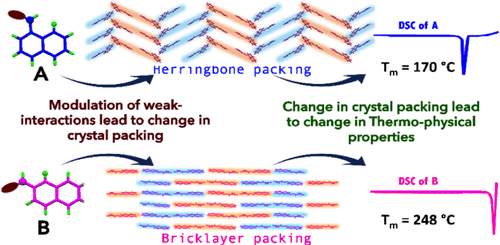Our official English website, www.x-mol.net, welcomes your
feedback! (Note: you will need to create a separate account there.)
Modulation of Weak Interactions in Structural Isomers: Positional Isomeric Effects on Crystal Packing and Physical Properties and Solid-State Thin-Film Fabrication.
ACS Omega ( IF 3.7 ) Pub Date : 2019-12-30 , DOI: 10.1021/acsomega.9b02962 Monika 1 , Abhineet Verma 1 , Manish Kumar Tiwari 1 , Bibhutibhushan Show 2 , Satyen Saha 1
ACS Omega ( IF 3.7 ) Pub Date : 2019-12-30 , DOI: 10.1021/acsomega.9b02962 Monika 1 , Abhineet Verma 1 , Manish Kumar Tiwari 1 , Bibhutibhushan Show 2 , Satyen Saha 1
Affiliation

|
Selective formation of positional isomers and accordingly tuning the physicochemical properties of small conjugated organic molecules through structural isomers is an effective crystal engineering for a fascinating successful delivery of thermally stable and photophysically exciting compounds. By small structural skeleton changes, the single crystal of the naphthalenemaleonitrile isomers is found to exhibit a drastic change in crystal packing array, which in turn is found to tune the thermal and physicochemical properties. The α-isomer (A) forms the "herringbone packing" (HP) due to peri-interaction-sensitive C-H···(Ar)π (Ar = naphthalene ring) interactions, and the β-isomer (B) forms the "bricklayer packing" (BP) due to π(C≡N)···π(Ar) stacking interactions. These two positional isomers have revealed insight of molecular packing-dependent structure-property relationship. In this report, we show that a simple modification of relatively less common weak interactions, such as C-H···π(Ar) ↔ π(C≡N)···π(Ar), through the preparation of isomers, can lead to a drastic change in crystal packing (HP ↔ BP). Also, this report demonstrates that by a small structural diversity, one can obtain significant changes in the physicochemical properties like melting behavior, enthalpy, entropy, and electrical properties in the solid state. Therefore, it transpires from this study that structural isomer provides a useful complement to intermolecular nonbonding interactions as a tool to design new promising materials.
中文翻译:

调节结构异构体中弱相互作用的作用:对晶体堆积和物理性质以及固态薄膜制造的位置异构效应。
位置异构体的选择性形成以及通过结构异构体相应地调节小共轭有机分子的物理化学性质是有效成功地传递热稳定和光物理激发性化合物的有效晶体工程。通过小的结构骨架变化,发现萘马来腈异构体的单晶在晶体堆积阵列中表现出剧烈变化,进而发现其可以调节热和物理化学性质。由于对周边相互作用敏感的CH···(Ar)π(Ar =萘环)相互作用,α-异构体(A)形成“人字形堆积”(HP),β-异构体(B)形成“ π(C≡N)···π(Ar)的堆积相互作用导致了“砖砌填料”(BP)。这两个位置异构体揭示了分子堆积依赖性结构-性质关系的见解。在此报告中,我们表明,通过制备异构体,对相对较少见的弱相互作用(例如CH···π(Ar)↔π(C≡N)···π(Ar))进行的简单修饰可导致导致晶体堆积发生剧烈变化(HP↔BP)。而且,该报告表明,通过小的结构多样性,可以在固态下获得物理化学性质(如熔融行为,焓,熵和电性质)的重大变化。因此,从这项研究可以看出,结构异构体为分子间非键相互作用提供了有用的补充,可以作为设计新材料的工具。我们表明,通过制备异构体,对相对不那么常见的弱相互作用(例如CH···π(Ar)↔π(C≡N)···π(Ar))进行的简单修饰可导致剧烈变化在晶体包装中(HP↔BP)。而且,该报告表明,通过小的结构多样性,可以在固态下获得物理化学性质(如熔融行为,焓,熵和电性质)的重大变化。因此,从这项研究可以看出,结构异构体为分子间非键相互作用提供了有用的补充,可以作为设计新材料的工具。我们表明,通过制备异构体,对相对不那么常见的弱相互作用(例如CH···π(Ar)↔π(C≡N)···π(Ar))进行的简单修饰可导致剧烈变化在晶体包装中(HP↔BP)。而且,该报告表明,通过小的结构多样性,可以在固态下获得物理化学性质(如熔融行为,焓,熵和电性质)的重大变化。因此,从这项研究可以看出,结构异构体为分子间非键相互作用提供了有用的补充,可以作为设计新材料的工具。人们可以在物理化学性质上获得重大变化,例如固态的熔融行为,焓,熵和电学性质。因此,从这项研究可以看出,结构异构体为分子间非键相互作用提供了有用的补充,可以作为设计新材料的工具。人们可以在物理化学性质上获得重大变化,例如固态的熔融行为,焓,熵和电学性质。因此,从这项研究可以看出,结构异构体为分子间非键相互作用提供了有用的补充,可以作为设计新材料的工具。
更新日期:2020-01-14
中文翻译:

调节结构异构体中弱相互作用的作用:对晶体堆积和物理性质以及固态薄膜制造的位置异构效应。
位置异构体的选择性形成以及通过结构异构体相应地调节小共轭有机分子的物理化学性质是有效成功地传递热稳定和光物理激发性化合物的有效晶体工程。通过小的结构骨架变化,发现萘马来腈异构体的单晶在晶体堆积阵列中表现出剧烈变化,进而发现其可以调节热和物理化学性质。由于对周边相互作用敏感的CH···(Ar)π(Ar =萘环)相互作用,α-异构体(A)形成“人字形堆积”(HP),β-异构体(B)形成“ π(C≡N)···π(Ar)的堆积相互作用导致了“砖砌填料”(BP)。这两个位置异构体揭示了分子堆积依赖性结构-性质关系的见解。在此报告中,我们表明,通过制备异构体,对相对较少见的弱相互作用(例如CH···π(Ar)↔π(C≡N)···π(Ar))进行的简单修饰可导致导致晶体堆积发生剧烈变化(HP↔BP)。而且,该报告表明,通过小的结构多样性,可以在固态下获得物理化学性质(如熔融行为,焓,熵和电性质)的重大变化。因此,从这项研究可以看出,结构异构体为分子间非键相互作用提供了有用的补充,可以作为设计新材料的工具。我们表明,通过制备异构体,对相对不那么常见的弱相互作用(例如CH···π(Ar)↔π(C≡N)···π(Ar))进行的简单修饰可导致剧烈变化在晶体包装中(HP↔BP)。而且,该报告表明,通过小的结构多样性,可以在固态下获得物理化学性质(如熔融行为,焓,熵和电性质)的重大变化。因此,从这项研究可以看出,结构异构体为分子间非键相互作用提供了有用的补充,可以作为设计新材料的工具。我们表明,通过制备异构体,对相对不那么常见的弱相互作用(例如CH···π(Ar)↔π(C≡N)···π(Ar))进行的简单修饰可导致剧烈变化在晶体包装中(HP↔BP)。而且,该报告表明,通过小的结构多样性,可以在固态下获得物理化学性质(如熔融行为,焓,熵和电性质)的重大变化。因此,从这项研究可以看出,结构异构体为分子间非键相互作用提供了有用的补充,可以作为设计新材料的工具。人们可以在物理化学性质上获得重大变化,例如固态的熔融行为,焓,熵和电学性质。因此,从这项研究可以看出,结构异构体为分子间非键相互作用提供了有用的补充,可以作为设计新材料的工具。人们可以在物理化学性质上获得重大变化,例如固态的熔融行为,焓,熵和电学性质。因此,从这项研究可以看出,结构异构体为分子间非键相互作用提供了有用的补充,可以作为设计新材料的工具。











































 京公网安备 11010802027423号
京公网安备 11010802027423号